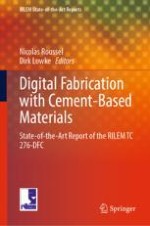2022 | OriginalPaper | Chapter
5. Properties and Testing of Printed Cement-Based Materials in Hardened State
Authors : Jolien Van Der Putten, Venkatesh Naidu Nerella, Viktor Mechtcherine, Mélody D’Hondt, Mohammed Sonebi, Daniel Weger, Zhendi Wang, Constantino Menna, Nicolas Roussel, Dirk Lowke, Kim Van Tittelboom, Geert De Schutter
Published in: Digital Fabrication with Cement-Based Materials
Publisher: Springer International Publishing
Activate our intelligent search to find suitable subject content or patents.
Select sections of text to find matching patents with Artificial Intelligence. powered by
Select sections of text to find additional relevant content using AI-assisted search. powered by
